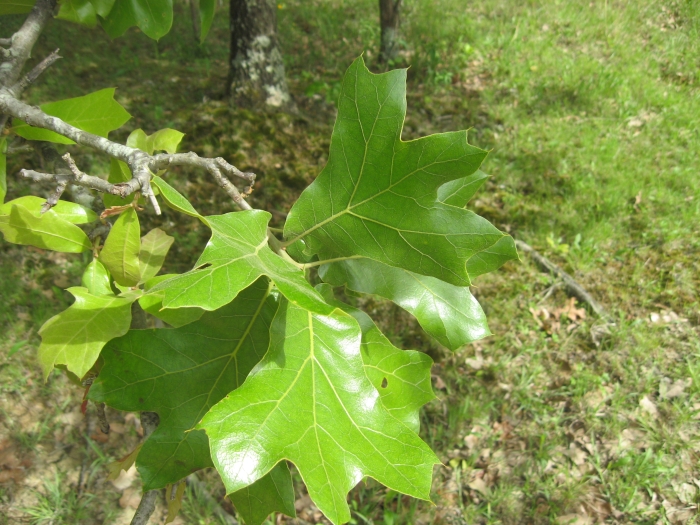Blackjack Oak
(Quercus marilandica)
Blackjack Oak (Quercus marilandica)
/
/

Mason Brock (Masebrock)
Public domain
Image By:
Mason Brock (Masebrock)
Recorded By:
Copyright:
Public domain
Copyright Notice:
Photo by: Mason Brock (Masebrock) | License Type: Public domain | License URL: https://creativecommons.org/public-domain/ | Uploader: IKAl | Publisher: Wikimedia Commons | Title: Lewis_County_Blackjack_Oak.JPG | Notes: User created page with UploadWizard |




















































Estimated Native Range
Summary
Quercus marilandica, commonly known as Blackjack Oak, is a deciduous tree or shrub native to dry, poor soils in open woodlands, forest clearings, and scrublands in the Eastern and Central United States. It is a small to medium-sized tree, typically growing to 15 meters (49 feet) tall. The bark is distinctive, cracked into rectangular black plates with narrow orange fissures. Leaves are leathery, dark green, and glossy on the upper surface, with a pubescent underside. They are variable in shape, often with a bell-like outline, and can remain on the tree through winter after turning a spectrum of red to brown in the fall. The acorn is small and, like those of other red oaks, requires 18 months to mature.
The Blackjack Oak is valued for its adaptability to poor soils and its ability to withstand drought, making it suitable for xeriscaping. Its tough, leathery leaves resist wilting, and the tree’s ability to thrive in less fertile soils makes it a good choice for reclamation projects. It is also used in native plantings and as a wildlife habitat, providing food and shelter for various species. In cultivation, it prefers full sun and can tolerate a range of soil conditions, but it does best in well-drained soils. While not commonly used in urban settings due to its irregular form, it can serve as a rugged, drought-tolerant tree in rural landscapes.CC BY-SA 4.0
The Blackjack Oak is valued for its adaptability to poor soils and its ability to withstand drought, making it suitable for xeriscaping. Its tough, leathery leaves resist wilting, and the tree’s ability to thrive in less fertile soils makes it a good choice for reclamation projects. It is also used in native plantings and as a wildlife habitat, providing food and shelter for various species. In cultivation, it prefers full sun and can tolerate a range of soil conditions, but it does best in well-drained soils. While not commonly used in urban settings due to its irregular form, it can serve as a rugged, drought-tolerant tree in rural landscapes.CC BY-SA 4.0
Plant Description
- Plant Type: Tree, Shrub
- Height: 20-40 feet
- Width: 20-30 feet
- Growth Rate: Slow
- Flower Color: N/A
- Flowering Season: Spring
- Leaf Retention: Deciduous
Growth Requirements
- Sun: Full Sun
- Water: Low
- Drainage: Medium, Fast
Common Uses
Bee Garden, Bird Garden, Butterfly Garden, Drought Tolerant, Fire Resistant, Low Maintenance, Rabbit Resistant, Salt Tolerant
Natural Habitat
Native to dry, poor soils in open woodlands, forest clearings, and scrublands in the Eastern and Central United States
Other Names
Common Names:
Scientific Names: , Quercus marilandica, Quercus marilandica var. ashei, Quercus ferruginea, Quercus dilatata, Quercus marilandica f. incisa, Quercus neoashei, Quercus marilandica f. aequilobata, Quercus marilandica f. cuneata, Quercus marilandica f. integrifolia
GBIF Accepted Name: Quercus marilandica (L.) Münchh.